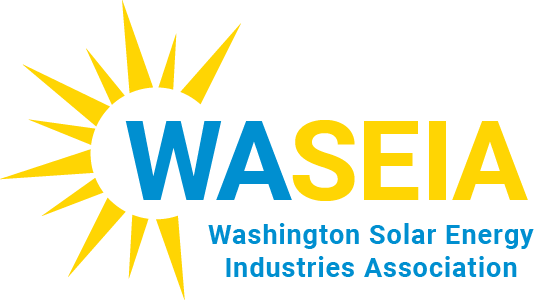This week the Trump Administration announced a four-year tariff program on imported solar cells and modules (solar panels), declaring an intention to provide relief for U.S. manufacturers against what they perceive as unfair trade practices. Based on a petition from manufacturers Suniva and SolarWorld Americas in mid-2017, the International Trade Commission (ITC) determined that increased solar cell and module imports “are a substantial cause of serious injury to the domestic industry.”
We are still in the early days, and awaiting official publication of the tariff in the Federal Register, but here is what we know about the tariff so far, and how we expect it to affect the Washington solar market:
Solar in National Headlines: Breaking Down the Numbers
February 7, 2018 is the start date for the tariff. It is scheduled to be in effect for four years, starting at 30% and stepping down by 5% each year. As prices for solar equipment are generally spoken of in dollars or cents per watt, this roughly equates to an average $0.10/watt tariff in 2018, ending in a $0.04/watt tariff in year four (GTM Research). While these are not the numbers we would like to see, the impact is not as negative as the industry as a whole initially feared; those most affected had already been preparing for the 50% tariff that Suniva and SolarWorld had requested.
The Solar Energy Industries Association (SEIA) issued a press release stating that this decision will cause the loss of roughly 23,000 American jobs. In the podcast Trump’s Solar Tariffs: We Answer Your Questions, GTM Research discusses the distinction that this is not current jobs being lost, but rather a reduction in jobs created based on the estimated solar demand models from the National Renewable Energy Laboratory (NREL). According to industry experts, job growth is expected to continue, but at a lower rate than recent employment trends indicated.
Where do we expect these changes to be felt the most? The 2016 National Solar Jobs Census found that the solar industry employed over 260,000 workers by the end of 2016, accounting for 1 in 50 new jobs created in the United States. Most of these jobs were in installation (137,000), and manufacturing accounted for 38,000 jobs, with the remainder in sales and distribution, project development, research and development, and finance. Proportionally, the biggest impact on jobs will be on the installation sector, however, more specifically, the impact will be weighted more toward utility-scale solar.
Of the expected 7.6 gigawatt reduction in new solar growth over the next five years, about 65% is expected from utility-scale. With projects of this scale, margins are very thin and module prices make up a larger percentage of development costs. The lead-up to the ITC ruling provided an opportunity for developers to plan for increased costs and led to advanced procurement of imported modules before the tariffs go into effect. As such, GTM Research expects 2018 to be relatively insulated from the tariffs, with 2019 having the biggest impact on the utility sector.
In the residential solar sector, tariff impacts will be reduced, due to modules making up a smaller percentage of system and installation costs. The exception will likely be new and emerging state solar markets. Southern states such as Texas, Florida, and South Carolina are expected to be among the most significantly impacted, with Suniva’s home state of Georgia the fourth most affected market. Oregon comes in as eighth most affected and is home to SolarWorld Americas.
The Outlook for Washington State’s Solar Market
Beginning with the implementation of the production incentive program in 2006, Washington’s solar market has functioned a little differently from other states. Our state incentivizes customers for installing locally-manufactured solar equipment. Because of this incentive, we have a healthy manufacturing base in Washington State that may initially benefit from this tariff decision. Thus far, Washington has not seen large development in utility-scale solar, with most solar installers in the state focusing primarily on the residential market.
An important detail in this tariff decision is an exemption for the first 2.5 gigawatts of solar cells imported to the United States. While this tariff does not currently have an exemption for imports from NAFTA countries, Canada and Mexico, these negotiations are sure to continue. Industry experts have suggested that the first 2.5 gigawatts of solar cells should adequately supply existing U.S. manufacturing facilities for one year, further mitigating the impact on American manufacturers. The vast majority of solar module manufacturers purchase cells on the international open market, due to the limited number of cell manufacturers worldwide.
Locally, it looks as though prices will stabilize at 2017 levels for the foreseeable future. With state incentive rates stepping down in July 2018, Washington customers considering solar for their home or business would be wise to start planning their solar installations now.
While U.S. trade policy may be beyond the direct control of the Washington solar industry, the state’s solar businesses and customers can influence the long-term viability of solar in Washington State by advocating for solar-friendly policies at the state and local level. Right now, solar supporters can contact their legislators in support of the Solar Fairness Act (SB 6081). This bill would increase the number of new customers to which utilities’ must offer net energy metering, allocate any excess net metered credits to low income relief, and adjust the net metering true-up date to better reflect annual production capacity in Washington’s market.
(An earlier version of this post appeared on the website of Western Solar.)
Recommended Reading/Listening
- Section 201 Imported Solar Cells and Modules Fact Sheet
- GTM Podcast: Trump’s Solar Tariffs: We Answer Your Questions
- GTM: New Tariffs to Curb US Solar Installations by 11% Through 2022
- GTM: Trump Administration Issues 30% Solar Panel Import Tariff
- SEIA Press Release: President’s Decision on Solar Tariffs is a Loss for America
- SIW Press Release: Washington Solar Industry Remains Strong Despite Imposition of Import Tariffs
- WA Legislative Tracker: Solar Fairness Act (SB 6081)

